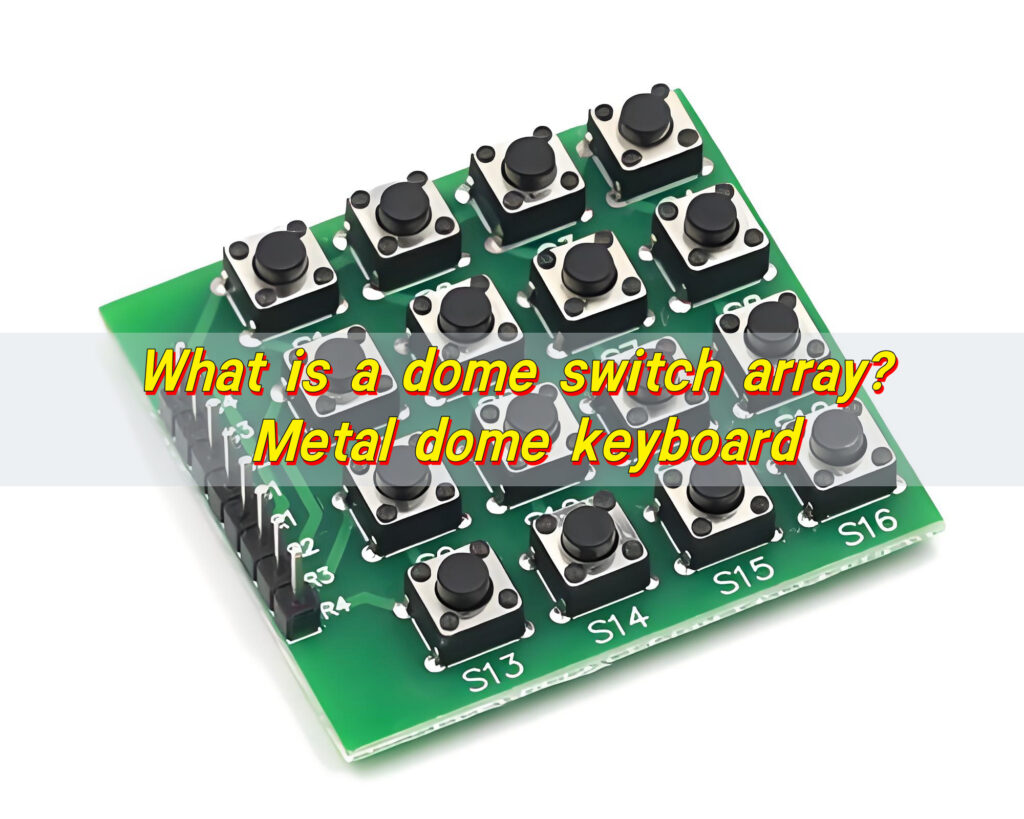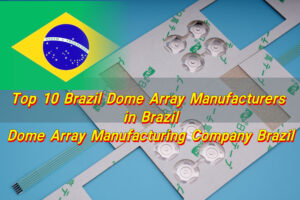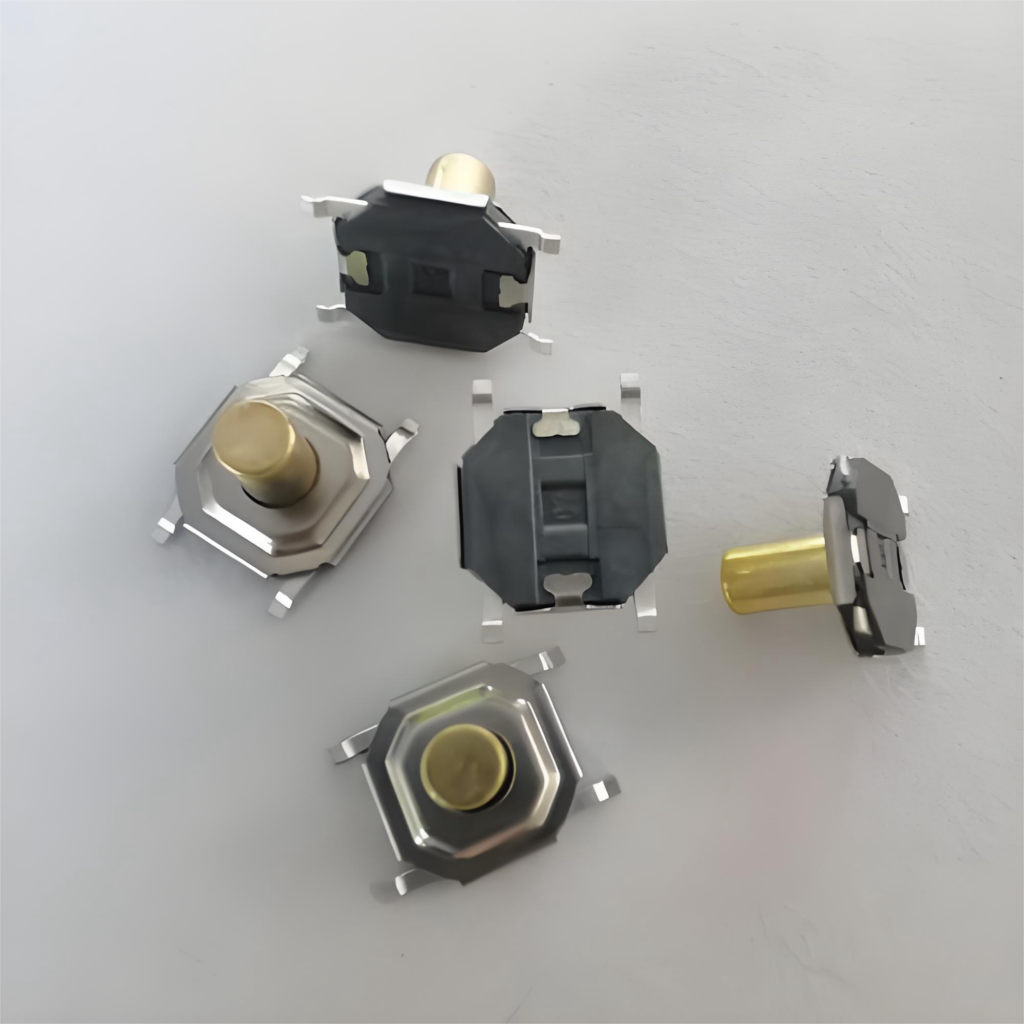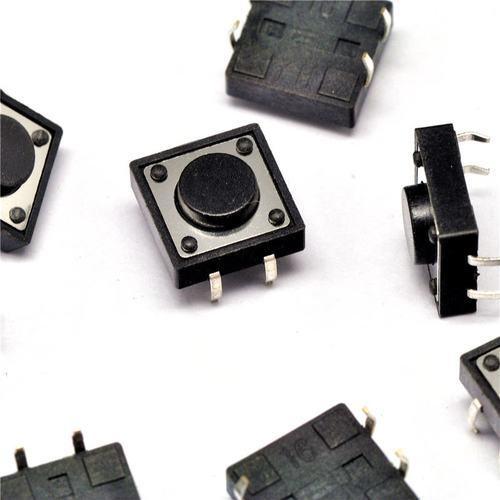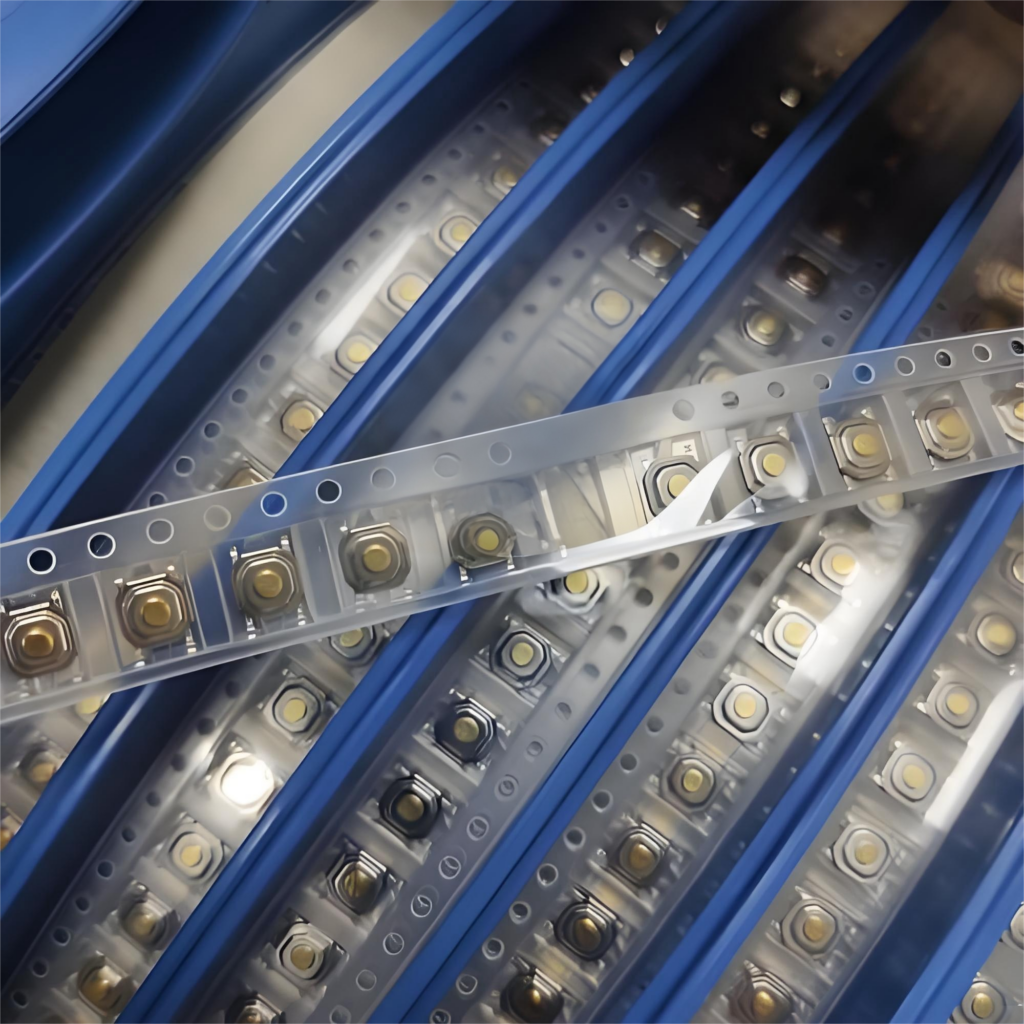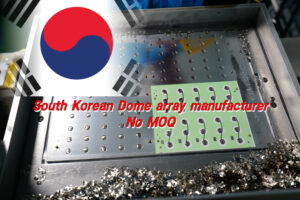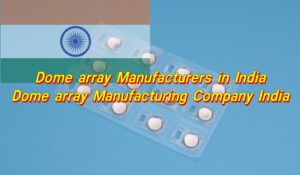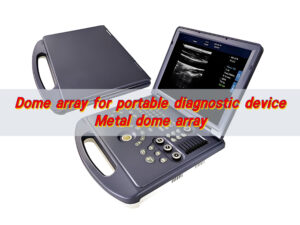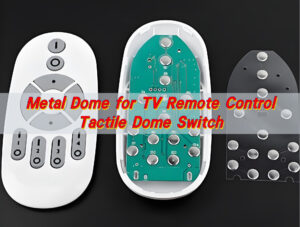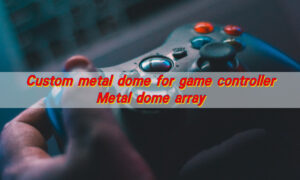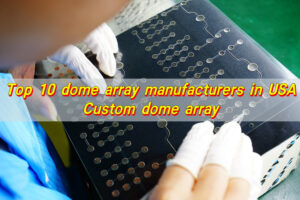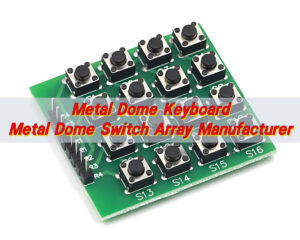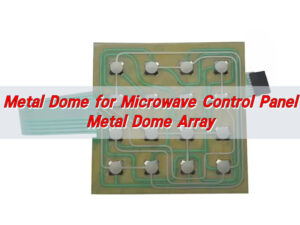A dome switch array is a sheet of metal domes arranged to form multiple tactile contact points. When pressed, each dome provides a crisp click, similar to a metal dome keyboard.
What Is a Metal Dome Switch Array?
A metal dome switch array is a type of tactile switch structure used to create responsive buttons on electronic devices. It’s a small yet essential component that translates a user’s touch into an electrical signal. Each dome acts as a miniature spring, made from stainless steel or other conductive metals, and is positioned on a printed circuit or membrane layer.
When pressed, the dome collapses with a distinct tactile snap. This action closes the circuit beneath, sending a clean and reliable signal to the device. Once released, it instantly returns to its original dome shape, ready for the next press. The design is compact, durable, and delivers that crisp, satisfying feedback users love in control panels, remote controls, medical devices, and even industrial keyboards.
The dome switch array structure usually consists of several domes arranged in a matrix pattern. This layout provides a uniform tactile response across multiple keys or buttons. The array may be bonded to an adhesive layer or integrated with a flexible printed circuit (FPC).
How Does a Tactile Dome Switch Work?
The tactile dome switch operates through a clever combination of mechanical movement and electrical contact. Each dome is shaped like a tiny hemisphere made of stainless steel. On the top side, it stays convex and slightly elevated. Underneath, it sits above conductive pads printed on a circuit board or flexible film.
When a user presses down, the dome collapses, momentarily connecting the upper and lower circuit layers. This “snap” action produces both a tactile and audible feedback. The instant you release pressure, the dome flexes back, breaking the circuit and resetting the switch for the next activation.
The tactile curve can be customized based on dome size, thickness, and shape. A higher dome height increases travel distance and feedback strength, while thinner domes provide softer clicks.
The material quality also matters. Stainless steel domes are corrosion-resistant and can endure over a million presses without losing elasticity. Some arrays are gold-plated for improved conductivity and oxidation resistance.
Unlike rubber or membrane switches, tactile dome switches maintain consistent actuation force and bounce time. The signal they produce is clean, avoiding false triggers or lag.
Why Use a Metal Dome Array in Electronics?
Whether it’s a handheld device, a control module, or a medical instrument, the way a button feels can influence how users perceive the entire product. This is where the metal dome array shines.
- First, it offers exceptional tactile feedback. Each press gives a crisp, responsive click that confirms input instantly. Users don’t need to guess whether the button registered.
- Second, Stainless steel domes maintain their shape and function through extensive use. They resist fatigue, oxidation, and wear even under demanding conditions.
- Third, design flexibility is another strong advantage. Dome arrays can be produced in various diameters, actuation forces, and materials to suit different product designs.
- Finally, space efficiency makes the metal dome array ideal for compact electronics. Unlike traditional mechanical switches, domes are low-profile, lightweight, and easy to integrate. They fit into slim product housings without sacrificing performance.
How Does a Dome Array Improve Button Feel?
The tactile sensation of a button is often underestimated. However, the dome array directly shapes how every press feels and sounds.
When a dome is pressed, it quickly collapses at a specific force threshold. This sudden “snap” provides both resistance and feedback. It reduces user error and enhances satisfaction.
Because each dome in the metal dome array is precisely engineered, the feedback remains consistent across every key. This consistency is crucial for multi-button layouts, such as in medical diagnostic devices or control panels.
Moreover, the rebound must be fast enough to prepare for the next input yet controlled to avoid bounce or vibration.
Where Are Dome Switches Commonly Used?
You’ll find dome switches in countless devices, often hidden beneath sleek overlays and control panels. Their combination of reliability, slim design, and tactile response makes them versatile across industries.
In consumer electronics, dome switch arrays are used in remote controls, mobile keypads, and game controllers. Users enjoy the satisfying tactile click without any mechanical noise or sluggish feedback.
In industrial equipment, the metal dome keyboard stands out for its ruggedness. Operators rely on it in control consoles, factory automation systems, and heavy machinery panels. Even in harsh environments, the domes maintain consistent operation with minimal wear.
In the medical field, tactile dome switches appear in diagnostic instruments and patient monitoring systems. Medical staff require precise input feedback, especially when operating under pressure. The clean, sealed design also resists dust and moisture, which helps maintain hygiene.
The automotive industry adopts dome arrays for dashboards, steering wheel controls, and infotainment interfaces. The tactile feedback ensures drivers can interact without needing to look down, improving safety and usability.
Finally, smart appliances and wearable devices use miniature dome arrays for compact, intuitive input. Whether adjusting volume, selecting functions, or powering on, users appreciate the consistent feel.
What’s the Key Difference: Dome Switch vs Mechanical?
While both dome switches and mechanical switches provide tactile feedback, their structure and feel are quite different.
A dome switch relies on a flexible metal dome that collapses under pressure to close a circuit. Its actuation point is shallow and crisp, with minimal travel. Dome switches also produce a clean, short click sound with low actuation force.
A mechanical switch, on the other hand, uses a spring-loaded stem and housing. It provides deeper travel and a more pronounced tactile bump. Mechanical switches are often found in high-end keyboards or control panels that demand extended movement and higher force.
In terms of durability, both types can last for millions of actuations. However, dome arrays generally offer a thinner and more flexible layout, while mechanical switches are bulkier and less suitable for compact electronics.
Another key point is environmental resistance. Metal dome arrays can be sealed with adhesive films, creating a dustproof and waterproof layer. Mechanical switches often require additional protection to achieve the same level of sealing.
From a design perspective, dome switches allow for more freedom. They can be shaped, layered, and customized without adding thickness.
Is a Metal Dome Keyboard Better Than Mechanical?
The comparison between a metal dome keyboard and a mechanical keyboard often comes down to application and user preference. Each has its unique strengths, but metal dome keyboards deliver several compelling advantages in specific environments.
Metal dome keyboards are lightweight and low-profile, making them ideal for compact equipment. They maintain consistent tactile feel across all keys without the need for bulky switch housings. This makes them especially suitable for medical, industrial, and portable devices.
Another advantage is quiet operation. The click of a metal dome is subtle, but not noisy. In workplaces or labs where silence matters, this makes a big difference.
Moreover, metal dome switch arrays are more resistant to environmental stress. They can be sealed against moisture, dust, and chemicals, ensuring reliable performance over long cycles. Mechanical keyboards typically need extra enclosures for similar protection.
From a cost perspective, metal dome designs often provide a more economical solution for large-scale production while maintaining premium tactile quality.
While mechanical keyboards remain popular for gaming and desktop use, metal dome keyboards dominate professional applications where precision, space efficiency, and longevity are priorities.
How to Choose the Right Metal Dome Switch Array?
Selecting the proper metal dome switch array depends on understanding your device’s needs. The following are the main considerations to be assessed before finalizing the dome structure.
- 1. Dome Size and Force:
Larger domes generally offer more tactile travel, while smaller domes provide tighter response. Actuation force, measured in grams, determines how hard the button feels to press.
- 2. Material and Plating:
Most domes use stainless steel, but coatings like gold or nickel can improve conductivity and corrosion resistance. In environments exposed to humidity or chemicals, plated domes are a smart investment.
- 3. Circuit Interface:
Consider whether your dome array will mount on a membrane circuit, flex circuit, or rigid PCB. Each setup requires specific adhesive strength and alignment precision.
- 4. Environmental Conditions:
If the product operates outdoors or in harsh environments, opt for domes with sealing layers or PET films. These protect against dust, water, and oxidation without affecting tactile feel.
- 5. Customization Needs:
Many suppliers offer custom snap domes tailored to unique shapes, sizes, and tactile forces.
- 6. Life Cycle Requirements:
A high-quality metal snap dome should endure over one million actuations. For mission-critical applications like medical or defense equipment, durability testing and quality certifications are essential.
Conclusion:
Although dome switch arrays are small, they are very important for electronic design. Whether it’s a metal dome keyboard, industrial controller, or medical keypad, this technology blends tactile satisfaction with long-lasting performance.
If you’re developing devices that require tactile precision and dependable performance, partnering with a professional metal dome array manufacturer is crucial. For expert guidance, quality dome assemblies, and custom designs, contact sales@metal-domes.com


